RESPIRATORY CELL PHYSIOLOGY

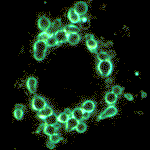 Darkfield microscopy of an AT II cell showing the limiting LB-membranes
Darkfield microscopy of an AT II cell showing the limiting LB-membranes
 AT II cells during agonist-induced Ca2+-oscillations
AT II cells during agonist-induced Ca2+-oscillations
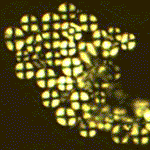 Polarization microscopy revealing a strong birefringence and a liquid-crystaline structure of intracellular LBs
Polarization microscopy revealing a strong birefringence and a liquid-crystaline structure of intracellular LBs
 Stably surface associated LBs (red fluorescent particles) and reflective LB-derived surface structures (cyan)
Stably surface associated LBs (red fluorescent particles) and reflective LB-derived surface structures (cyan)
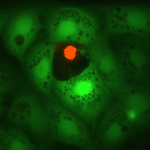 Vitality of cells judged by retention of a cytosolic marker, Calcein, and absence of nuclear staining by Ethidium homodimer-1 (red)
Vitality of cells judged by retention of a cytosolic marker, Calcein, and absence of nuclear staining by Ethidium homodimer-1 (red)
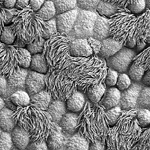 Bronchiolar ciliated cells seen by SEM
Bronchiolar ciliated cells seen by SEM
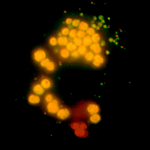 Co-staining of a type II cell with LTG and Nile Red (yellow). Red clusters mark surfactant in fused vesicles with dissipated proton gradients, green structures acidified endocytotic vesicles and probably kiss-and-run events devoid of lipids
Co-staining of a type II cell with LTG and Nile Red (yellow). Red clusters mark surfactant in fused vesicles with dissipated proton gradients, green structures acidified endocytotic vesicles and probably kiss-and-run events devoid of lipids
 LBs adsorbed to an air-liquid interface spontaneously transform into lipid expanded (Bodipy-PC; green) and lipid-condensed (DiIC(20); orange) states
LBs adsorbed to an air-liquid interface spontaneously transform into lipid expanded (Bodipy-PC; green) and lipid-condensed (DiIC(20); orange) states
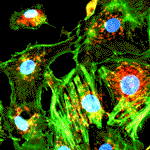 Selective staining of the f-actin cytoskeleton (green), the nucleus (blue) and mitochondria (red) of alveolar type II cells in culture
Selective staining of the f-actin cytoskeleton (green), the nucleus (blue) and mitochondria (red) of alveolar type II cells in culture
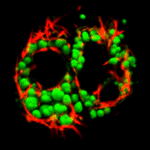 Fluorescently labeled Lamellar Bodies (green) of AT II cells are surrounded by highly energized mitochondria (red fluorescence of the mitochondrial potential-sensitive dye JC-1)
Fluorescently labeled Lamellar Bodies (green) of AT II cells are surrounded by highly energized mitochondria (red fluorescence of the mitochondrial potential-sensitive dye JC-1)
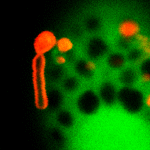 Release of pulmonary surfactant through the exocytotic fusion pore into the extracellular space proceeds by unraveling of the concentrical lipid membranes and their transformation into tubular structures. Surfactant (red) was visualized by FM 1-43, cytosol was stained with Calcein-AM
Release of pulmonary surfactant through the exocytotic fusion pore into the extracellular space proceeds by unraveling of the concentrical lipid membranes and their transformation into tubular structures. Surfactant (red) was visualized by FM 1-43, cytosol was stained with Calcein-AM
 The polar tracer Lucifer Yellow preferentially stains cytosol and nucleus of AT II cells leaving out the lumina of Lamellar Bodies (dark inclusions)
The polar tracer Lucifer Yellow preferentially stains cytosol and nucleus of AT II cells leaving out the lumina of Lamellar Bodies (dark inclusions)
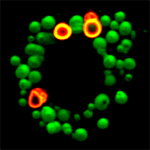 Fusion pore opening of Lamellar Bodies is visualized by FM1-43 (red), which enters the vesicular lumen from the outside and intercalates with lipid surfactant components. Pre-exocytotic vesicles are marked with LTG
Fusion pore opening of Lamellar Bodies is visualized by FM1-43 (red), which enters the vesicular lumen from the outside and intercalates with lipid surfactant components. Pre-exocytotic vesicles are marked with LTG
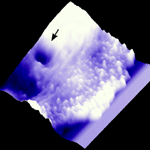 Surface dynamics at the periphery of a stimulated AT II cell observed by atomic force microscopy. Fusion pore opening (arrow) is visible as a deep, transient invagination of the plasma membrane
Surface dynamics at the periphery of a stimulated AT II cell observed by atomic force microscopy. Fusion pore opening (arrow) is visible as a deep, transient invagination of the plasma membrane
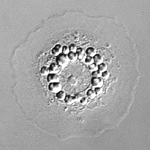 DIC microscopy improves the perceptibility of Lamellar Bodies, which appear as large, highly refractive spherical inclusions
DIC microscopy improves the perceptibility of Lamellar Bodies, which appear as large, highly refractive spherical inclusions
 Surface structure of an AT II cell in situ (Image size: 5x5µm)
Surface structure of an AT II cell in situ (Image size: 5x5µm)
 Surfactant protrusion (yellow) out of a fused lamellar body within a cluster of empty fusion pores
Surfactant protrusion (yellow) out of a fused lamellar body within a cluster of empty fusion pores
 Freshly released surfactant (center) instantaneously spreads into a surface film (black) when reaching an air-liquid interface
Freshly released surfactant (center) instantaneously spreads into a surface film (black) when reaching an air-liquid interface
 Surface film (bright area) and remnant structures (dark area, bright spots) after transformation of one lamellar body at a fluorescent air-liquid interface
Surface film (bright area) and remnant structures (dark area, bright spots) after transformation of one lamellar body at a fluorescent air-liquid interface
 Type II pneumocyte during global Ca2+-increase (red) and Ca2+-triggered exocytosis (blue spots)
Type II pneumocyte during global Ca2+-increase (red) and Ca2+-triggered exocytosis (blue spots)
 Surfactant during release through fusion pores usually maintain much of their packed structure (yellow)
Surfactant during release through fusion pores usually maintain much of their packed structure (yellow)
 Cantilever of an AFM (the tip cannot be seen) approaching an AT II cell (the central highly granulated one)
Cantilever of an AFM (the tip cannot be seen) approaching an AT II cell (the central highly granulated one)
 Extracellular surfactant, partially unfolded and unravelled by hydration and separation of the lipid bilayers
Extracellular surfactant, partially unfolded and unravelled by hydration and separation of the lipid bilayers
 Ballon-like extrusions: The outermost (or innermost) surfactant bilayers frequently separate from the core, suggesting a squeeze-out phenomenon
Ballon-like extrusions: The outermost (or innermost) surfactant bilayers frequently separate from the core, suggesting a squeeze-out phenomenon
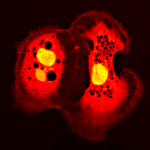 AT II cells, microinjected with Lucifer Yellow
AT II cells, microinjected with Lucifer Yellow
 Tearing surfactant out of a fusion pore: Red circle denotes the (invisible) focus of an infrared laser trap
Tearing surfactant out of a fusion pore: Red circle denotes the (invisible) focus of an infrared laser trap
 Living on the edge: Challenging a macrophage with an air-liquid interface
Living on the edge: Challenging a macrophage with an air-liquid interface
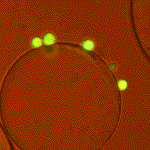 AT II cells (green) cultured on Solohill Microcarrier Beads
AT II cells (green) cultured on Solohill Microcarrier Beads
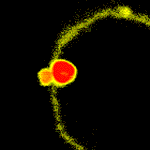 Confocal z-section of an AT II cell with plasma membrane (yellow) and surfactant (red)
Confocal z-section of an AT II cell with plasma membrane (yellow) and surfactant (red)
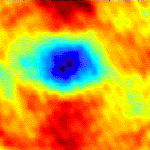 Interferometry of an AT II cell at an air-liquid interface (bulging of the interface is shown in blue)
Interferometry of an AT II cell at an air-liquid interface (bulging of the interface is shown in blue)
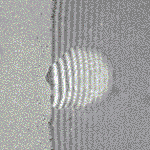 AT II cell at a PFC-water interface (PFC is on the left) and bending of interferometric fringes
AT II cell at a PFC-water interface (PFC is on the left) and bending of interferometric fringes
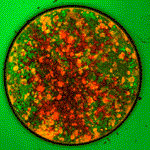 Lipid organisation at air-liquid interfaces is complex
Lipid organisation at air-liquid interfaces is complex
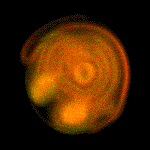 A giant multilamellar vesicle created from organic extracts of native surfactant
A giant multilamellar vesicle created from organic extracts of native surfactant
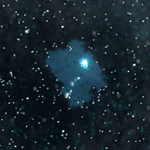 Distribution of gold nanoparticles (dots) on a surface-adsorbed lamellar body (blue area). Combined darkfield and fluorescence image
Distribution of gold nanoparticles (dots) on a surface-adsorbed lamellar body (blue area). Combined darkfield and fluorescence image
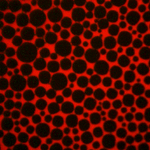 Complex organization of a fluorescent, environment-sensitive styryl dye (FM 1-43) at an inverted air-liquid interface
Complex organization of a fluorescent, environment-sensitive styryl dye (FM 1-43) at an inverted air-liquid interface
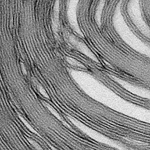 TEM close-up of internal lamellar body bilayer organization in high pressure/freeze substituted AT II cells
TEM close-up of internal lamellar body bilayer organization in high pressure/freeze substituted AT II cells
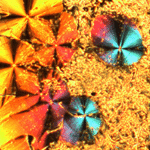 :Radial symmetric crystals formed out of a melt of DDT. Typical polarization patterns (Maltese cross) are visible
:Radial symmetric crystals formed out of a melt of DDT. Typical polarization patterns (Maltese cross) are visible
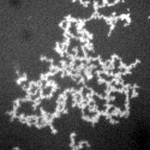 Fractal organization of surface textures by surfactant phospholipids and proteins at an air-liquid interface
Fractal organization of surface textures by surfactant phospholipids and proteins at an air-liquid interface
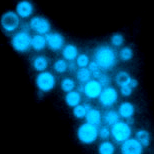 Near UV fluorescence of Laurdan is revealing a concentrical structure of Intracellular lamellar bodies
Near UV fluorescence of Laurdan is revealing a concentrical structure of Intracellular lamellar bodies
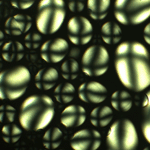 Starch granules used for optical calibrations in a polarization microscope
Starch granules used for optical calibrations in a polarization microscope
 CARS (Coherent anti-Stokes Raman Spectroscopy) image of an AT II cell demonstrating intracellular lipid deposits
CARS (Coherent anti-Stokes Raman Spectroscopy) image of an AT II cell demonstrating intracellular lipid deposits
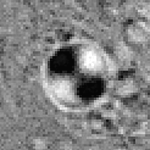 Separation of the fast (dark) and slow (bright) optical components within a birefringent Lamellar Body in situ (image acquired with crossed polarizers and a retardation plate)
Separation of the fast (dark) and slow (bright) optical components within a birefringent Lamellar Body in situ (image acquired with crossed polarizers and a retardation plate)
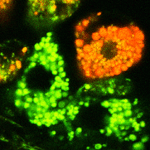 Primary human AT II cells demonstrating a considerable autofluorescence
Primary human AT II cells demonstrating a considerable autofluorescence
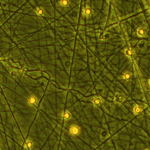 Gelatine matrix tested as a scaffold in cell culture
Gelatine matrix tested as a scaffold in cell culture
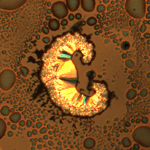 Unknown object, probably from outer space
Unknown object, probably from outer space
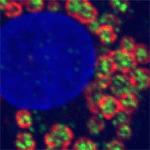 Immunofluorescence of SP-B (green) and ABCa3 (red) with nuclear stain by Hoechst (blue)
Immunofluorescence of SP-B (green) and ABCa3 (red) with nuclear stain by Hoechst (blue)
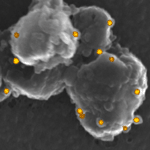 Immunogold labeling of SP-B (yellow) on extruded pulmonary surfactant, caught in the process of release from exocytosed vesicles in stimulated AT II cells
Immunogold labeling of SP-B (yellow) on extruded pulmonary surfactant, caught in the process of release from exocytosed vesicles in stimulated AT II cells
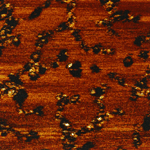 Force spectroscopy (Young’s modulus map) with an SP-C functionalized AFM cantilever. Specimen was a Lamellar Body adsorbed on mica
Force spectroscopy (Young’s modulus map) with an SP-C functionalized AFM cantilever. Specimen was a Lamellar Body adsorbed on mica
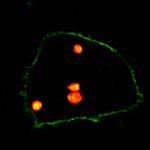 Z-sectioning of a stimulated cell (plasma membrane: green; apical side: bottom) revealing surfactant (red) containing post-exocytotic vesicles deep inside the cell
Z-sectioning of a stimulated cell (plasma membrane: green; apical side: bottom) revealing surfactant (red) containing post-exocytotic vesicles deep inside the cell
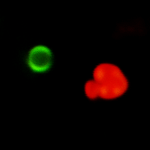 Following transient fusion and incomplete surfactant release, lamellar bodies are retrieved into the cell (red, FM 1-43), whereas extracellular surfactant is uncovered by alternative dyes (green, SP-DiOC18(3))
Following transient fusion and incomplete surfactant release, lamellar bodies are retrieved into the cell (red, FM 1-43), whereas extracellular surfactant is uncovered by alternative dyes (green, SP-DiOC18(3))
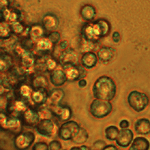 AT II cells cultured at an inverted air-liquid interface (brightfield)
AT II cells cultured at an inverted air-liquid interface (brightfield)
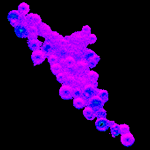 Generalized Polarization Function (GPF) of Laurdan, sensitive for the extent of water in the polar headgroups of lipid bilayers
Generalized Polarization Function (GPF) of Laurdan, sensitive for the extent of water in the polar headgroups of lipid bilayers
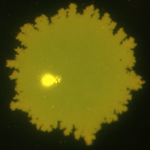 Fractal geometry and low line tension of a surface adsorbed lamellar body
Fractal geometry and low line tension of a surface adsorbed lamellar body
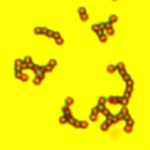 Fluorescent beads inserted into an inverted air-liquid interface to measure surface dynamics and Marangoni effects
Fluorescent beads inserted into an inverted air-liquid interface to measure surface dynamics and Marangoni effects
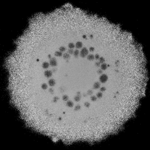 Calculated homogeneous Ca2+ elevation in a caged Ca2+ and flash-photolysis treated AT II cell
Calculated homogeneous Ca2+ elevation in a caged Ca2+ and flash-photolysis treated AT II cell
 TEM of an open fusion pore during active squeeze-out of surfactant into the extracellular space
TEM of an open fusion pore during active squeeze-out of surfactant into the extracellular space
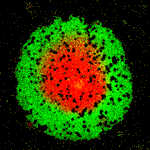 Giant, surface adsorbed unilamellar vesicle with ongoing lipid phase separation
Giant, surface adsorbed unilamellar vesicle with ongoing lipid phase separation
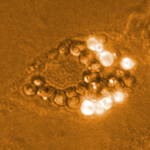 Actively degranulating AT II cell seen by DIC and FM 1-43 fluorescence
Actively degranulating AT II cell seen by DIC and FM 1-43 fluorescence
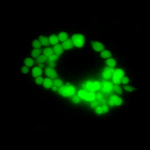 Lysotracker Green stain of acidified, intracellular and pre-exocytotic lamellar bodies
Lysotracker Green stain of acidified, intracellular and pre-exocytotic lamellar bodies
 Late stage of compound exocytosis viewed by Scanning Electron Microscopy (SEM)
Late stage of compound exocytosis viewed by Scanning Electron Microscopy (SEM)








